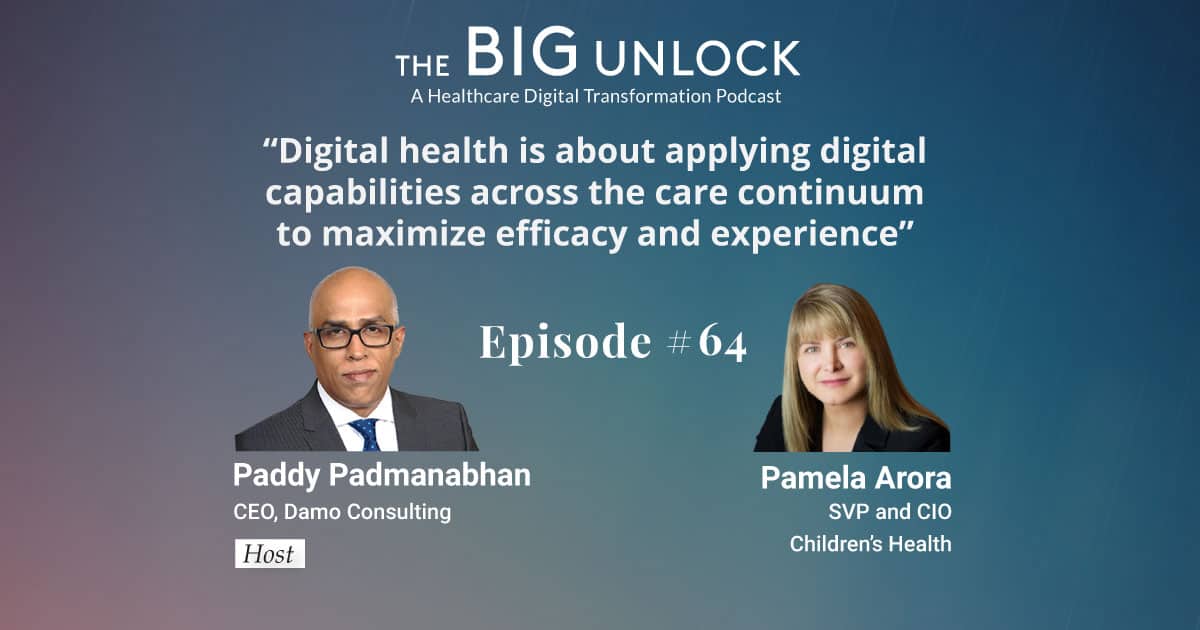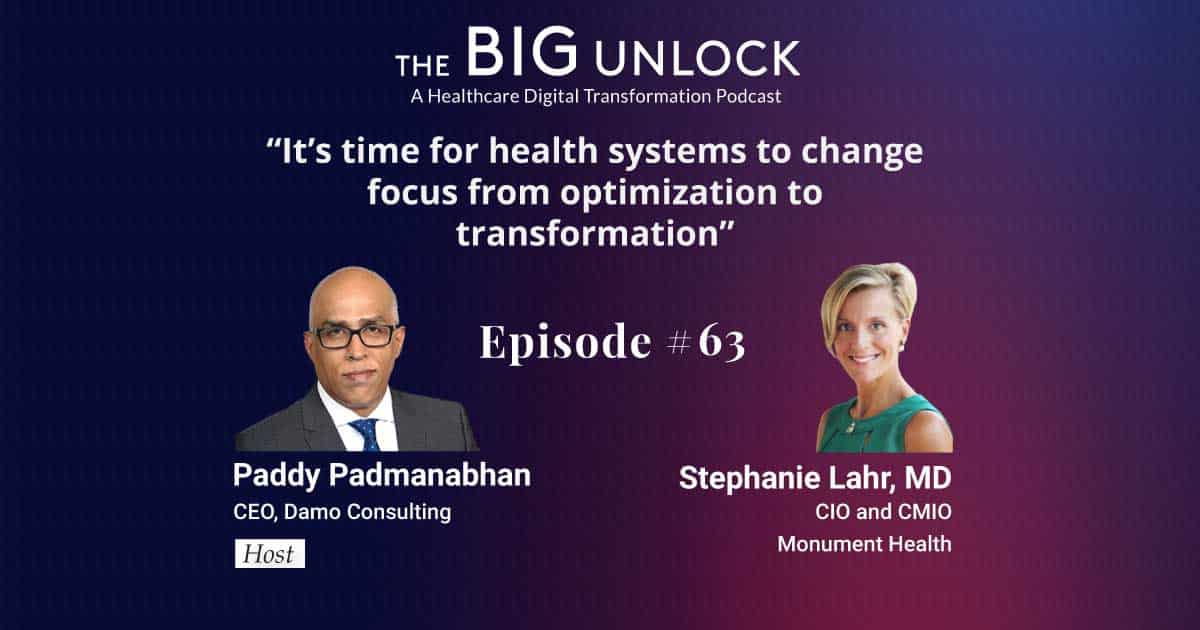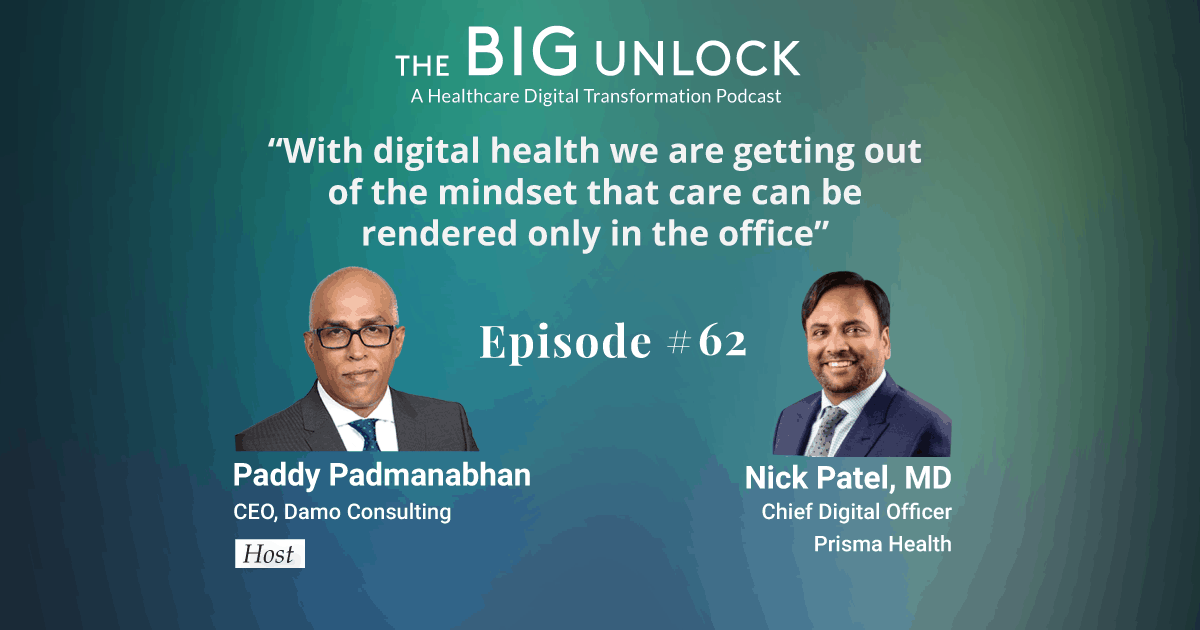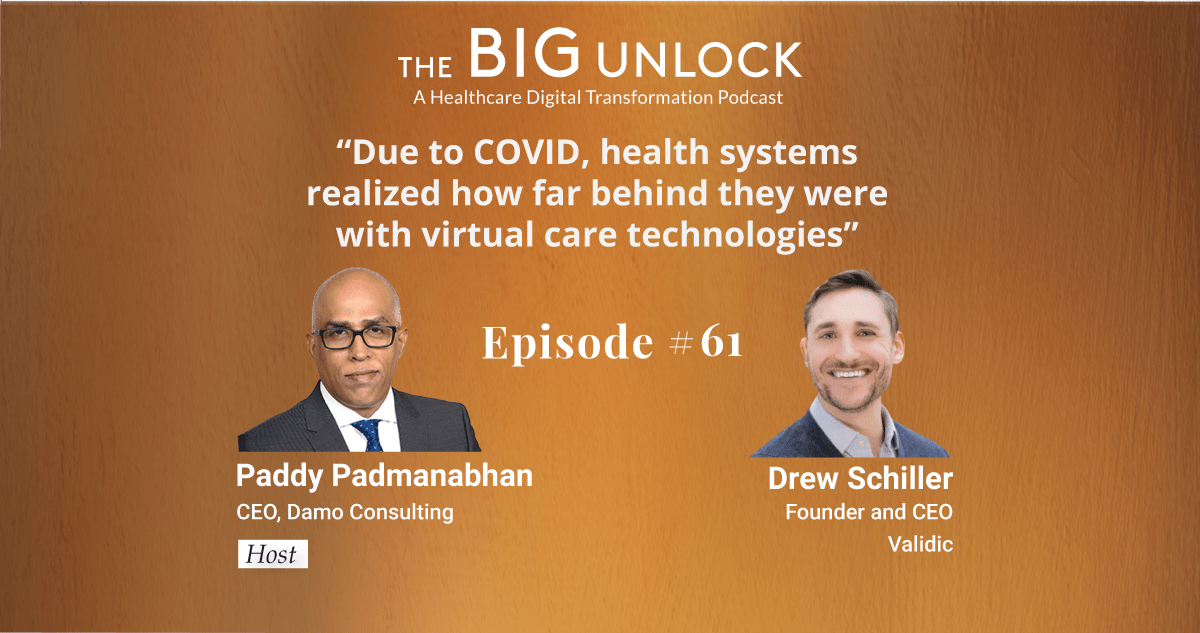Episode #64
Podcast with Pamela Arora, SVP and CIO, Children’s Health
"Digital health is about applying digital capabilities across the care continuum to maximize efficacy and experience"
 Hosted by Paddy Padmanabhan
Hosted by Paddy Padmanabhan 
Share
In this episode, Pamela Arora, SVP and CIO of Children’s Health discusses how their holistic approach towards digital health is transforming the experience of their team members, providers, patients, and the whole continuum of care. At Children’s Health, digital health is about effectively applying digital capabilities across the continuum of care to maximize efficiency, effectiveness, and experience.
According to Pamela, by increasing the touchpoints and simplifying data across the care continuum healthcare organizations can deliver the three E’s: efficiency, effectiveness, and experience. However, one of the challenges in achieving this digital engagement in healthcare involves the data itself. If an organization is taking a patient-centric approach, continuity of data is critical. To ensure data flows easily across the continuum of care, it is important to promote interoperability initiatives across the healthcare organizations.
Technology is the key element in any digital program of an organization. Assessing the right technology at the right time is crucial to enhance patient as well as provider experience. Other aspects while evaluating technology is to consider its ease of adaptability and reliability among providers so that they can deliver a seamless patient experience. Pamela suggests health systems to keep advancing with new technologies and start with pilot first approach and then scale up the process.
Pamela Arora, SVP and CIO, Children’s Health in conversation with Paddy Padmanabhan, CEO of Damo Consulting on the Big Unlock Podcast – “Digital health is about applying digital capabilities across the care continuum to maximize efficacy and experience”
PP: Hello everyone and welcome back to my podcast. It is my great privilege and honor today to introduce my special guest, Pamela Arora, Chief Information Officer of Children’s Hospital in Dallas. Thank you so much for setting aside the time and welcome to the show.
PA: My pleasure. Thank you very much, Paddy.
PP: You’re most welcome. So, let’s get started. Tell us a little bit about Children’s Health and the patient populations you serve.
PA: We have several hospitals and ambulatory clinics as well as extensive telehealth into schools and other community hospitals here in the Dallas Fort Worth area. It’s our honor to serve the patients and families in this community.
PP: This podcast is mostly about digital transformation and the technology enabling aspects of it. Could you give us an overview of the digital programs that you’re currently operating in your institution?
PA: Absolutely, Paddy. Our enterprise IT systems are designed to support enterprise organizational initiatives and strategies. I will give you an example, we have an enterprise initiative ‘becoming the difference together,’ it is really transforming the experience of our team members, our providers, our patients and those that enable and provide their care. And in this initiative, we apply digital capabilities across the continuum of care so that we can maximize the efficiency and effectiveness of the experience we deliver to our patient families. So, instead of just having these one of technology solutions, we really tried to look at technology holistically. And in light of this, ‘becoming the difference together’ enterprise initiative, our telehealth programs help to support that. Our patient monitoring programs allow patients to be in their home setting in some instances so that they don’t have to be in our hospital walls. Our voice recognition programs, for example, are initially piloted with providers and then really expanded to other care givers so that they can be more optimized in how they deliver that care experience. And then more specifically, our patient experience programs where we leverage mobility to make it more convenient for our patient families. We have a digital front door that can basically round you from your front door to the clinic’s door and the third floor of a particular building. So, as we’re looking at how we want to support digital, we really wrap it around these enterprise initiatives in the patient experience which is a really key one. But the patient experience touches on so many different technologies from telehealth to customer relationship management systems, CRM information that’s gathered and shared and used along the continuum of care, our electronic medical record, of course and that really is key to inform care delivery. But also, being able to work it so that it’s very patient family centric, even down to our biomedical devices. And how that information flows from a biomedical device into our EMR so it can trigger certain kinds of logic or allow us to make better decisions when we apply algorithms to that kind of data. But it gives you an idea of how holistic the programs are at Children’s when it comes to digital health.
PP: Yeah, I like that actually, your holistic approach which takes into account your core infrastructure and your systems but also look at emerging technologies in the context of digital health and digital transformation. How do you define digital health?
PA: I find every organization has different nuances to how they define it. But at Children’s Health, like the example I gave with enterprise initiatives, with ‘becoming the difference campaign.’ The way we look at digital health and how it’s defined, it’s through effectively applying our digital capabilities across the continuum of care and support structures thereby maximizing efficiency, effectiveness, and experience. When you think of pediatrics in that whole digital health experience, there are examples of where you can use the digital experience to enhance the capabilities that you’ve delivered at patient families.
PP: So you serve a very unique population group, you are a children’s hospital. What kind of unique capabilities did you have to develop a digital program to serve your populations?
PA: Very good question. And when you think about just care in general, we all have our own healthcare experience with ourselves, with our parents, with our children, with neighborhood folks that you see who are getting care delivered and having unique needs. But when you take a look at pediatrics, you’re really working with the family unit, not just patients. Children can always be sent on their own behalf and depending on their age in some cases they can. And as you are looking to kind of enhance an experience, you have to consider this broader support structure for those children. So, the beauty of the EHR is it’s highly configurable and very necessary, because, for example, we’re located in Texas and we need to configure to our state laws and regulations. If you work with a foster care CPS patient, in these cases, the data is not shared in our patient portal. It’ll be shared among clinicians, but it won’t be shared in a portal. It’s because we don’t want to place the patient or foster care families at risk. Once a patient is out of the foster care system, then we’re able to facilitate information sharing for the patient through our portal. At the same time, clinical data regarding these patients is available via interoperability, and it’s the capability that every EHR needs because basically you want clinicians to always have informed care. But that foster care example is kind of helpful for people to get around the nuances of what you have to do with the system to work it effectively. So, I will give you a second example. Adolescents are treated differently in every state. In Texas, certain conditions, such as drug, alcohol abuse, or STD status are shareable with parents and guardians. In other states, these conditions cannot be shared. This is a kind of unique area of pediatrics. But when you think about it, pediatrics is really addressed through Medicaid programs that are state governed and the state laws apply to patient’s health records. The adult world is different because patients are governed by the federal regulated Medicare program. So, these are some examples of where we have different nuances that need to be addressed according to a state regulation. But also, in some cases, preferences by a family unit versus just the individual patient and highly configurable systems allow us to simplify clinical and business workflows economically instead of high maintenance systems that require custom-built. We try to be a package implementation shop where we try to take things off the shelf and configure them. We don’t want to get into custom code if we can avoid it. But there are a handful situations where we actually need to do custom code because the market doesn’t supply what we need. But when it comes to patient families, there’s just a lot of areas that you have to make sure you handle appropriately and make the data available when it needs to be. But in certain instances, it doesn’t necessarily follow the rule for all patient families.
PP: Those are fascinating examples. I have no idea how intricated, how nuanced the laws are and how it varies from state to state when it comes to pediatrics. You mentioned technology choices and actually it is a great segue to my next topic of discussion. How do you go about assessing your technology choices, specifically in the context of digital programs? Where do you start? Do you start reading EHR or do you look for best in class tools? How do you go about it? Can you walk us through your typical thought process when it comes to this?
PA: When it comes to making technology choices, I offer a common quote, “just because you’re a hammer, not everything is a nail.” It’s important to understand the organization’s goals and recognize where technology can be a game changer and can better support your strategic direction. But while technology is a key element in digital programs, there are instances where process or culture change may make the most impact. In any event, the role of enterprise IT is to make sense of the architecture so we can economically build, buy, or rent the systems needed to support our vision. So, as we’re assessing technology, we kind of look at it and say, you know what makes sense at this particular time? Some solutions are better to build, some to buy and some are preferred to rent. For example, we originally built our data center out and it hosts our ERP system on site and that was a simple solution at that time. But several years back, our vendor eventually developed a solution that they can provide better, faster, and cheaper in the cloud. So, we shifted our model, and the key is the price point, because in some cases you have some investments in certain assets in your organization. But when we’re doing the technology refresh, we’re checking what is the right answer now. And in addition to that, we’re constantly monitoring to see if we need to make a change because we can do it more economically or in a more simplified way. IT tends to have to figure out how to simplify technology so it’s more adaptable. Similarly to the examples I gave about the enterprise and how you assess the technology, when you think about data flow across the continuum of care that’s inside the walls and outside our walls of our institutions. We are the ultimate Plummer, and we want the systems to be reliable, like a utility where you can just count on it. Our mind set is to create simplicity in your system so that it becomes a reliable tool that your organization can count on. And when a workflow or architecture is complex, IT should try and simplify its application to improve adoption. If a particular model is difficult to understand or use, providers won’t use it, your back-office staff won’t use it. Another plus for simplifying the utility of the system is cost savings, scalability, efficiency. All of those come into play when you try to work towards that simple, adaptable solution. For example, a solution we’re evaluating is a patient identification patch. They can place the armband and we use it to scan for medications. We use it to identify the patient and all of that’s taken care of. We’re currently piloting a technology that can replace that with a very thin patch that can go on the patient family. And not only it can identify the patient family member, but the patient be scanned through clothing, that can help monitor vital signs such as the pulse. Today, we have a little piece of equipment that clips to the patient, it’s not necessarily very comfortable, especially for tiny patients. So, anything we can do that can help the patient family experience from a comfort level, as well as improve the experience for providers and staff. Imagine in the middle of the night having to scan your child and they have to get to that armband, and they wake up the child because that’s the only way they can get to it. We’re talking about something that can identify the patient that much more readily scan through clothing so that child stays sleeping. And on top of that, be able to give you the vital signs. These types of technologies really get into hitting on all the aspects that really can help care because people think about the patient experience. But if we can’t provide an excellent clinical provider experience, then they’re not delivering the best care. So, we are pretty excited about that.
PP: Those are great examples. In fact, you talk about the experience in context of providers. You mentioned a couple of times that the technology has to be easy to use to gain adoption, at least among the providers. With digital, it’s a whole different expectation. As consumers we’re all used to seamless experiences from the retailing industry, the e-commerce industry, the personal banking industry and so on. Healthcare by all accounts has catching up to do in that context. What are some of the big challenges that you see when it comes to engagement and adoption with your user community, namely your patient and all your patient families when you roll out some of these tools?
PA: Very good question. I also have worked in multiple industries prior to being a CIO in healthcare. At one point I was the CIO of Ross Perot’s company, Perot Systems, and had a chance to work in about every industry. And I’ve been able to really witness different types of consumer engagement. And as a patient in the health system I experienced varying levels of engagement as well because we all have our own healthcare experience. One of the challenges of digital engagement in healthcare involves data. And this is something that I respectfully share when I talk to peers in manufacturing and different industries. If an organization such as mine is taking a patient-centric approach, continuity of data is critical because it informs patient care. However, patient data is fragmented because it’s created in different provider organizations and not within our four walls. That is why it’s important to promote interoperability initiatives to make data flow easier across the continuum of care. And back to that example of foster care, the patient could receive care in varying locations with different families over the course of their youth. And in this type of situation, the impact of interoperability is evident. I mean, it can get down to just whether it’s safe care or not if you’re not aware of certain challenges and different kinds of prior clinical care delivery, that could impact it when a physician is delivering care to that patient and if the data can be integrated, it makes it much easier for the provider to be more effective and deliver informed care. Also, it’s just catering to preferences. Maybe that patient family prefers to be communicated with text or prefers Thursday appointments versus Monday appointments. If the data isn’t integrated, providers may not have full visibility into the care of the patient, including those support systems, support processes like scheduling. So, it’s important when you consider the constant frequency of how these are used. I am going to give you another example. Think of testing or think of even immunizations. Without visibility into the patient’s care, you could subject a patient to multiple tests that may have already been completed. Bottom line is, if you don’t have visibility to that data and various touchpoints within the health system then it all needs to come together so that a patient can have a favorable experience because you have to know the patient and you have to know their needs.
PP: Fascinating examples. How do you measure success with your digital health programs? Imagine you’re making the investments today. You talked about a number of them. How do you go about measuring the impact and measuring success?
PA: With our existing enterprise programs, we continue to extend their reach and in turn impacts our organization and the communities such as our EHR, EMR (electronic medical record) and our ERP solutions, enterprise resource planning and CRM solutions. In some areas we see more opportunity for growth. We have a lot more that we can do with our patient-centric focus by building up the data in our customer relation management system. It’s getting a lot of attention right now, but as far as its success some of its reach, one thing for the system to be able to have that reach; another is for the system to be adapted and be able to see the growth in the populations that are using it. So, take telehealth, for example, we have an existing infrastructure that is being used to support our telehealth programs and they have been in place for over a decade. We are continuously looking to enhance our tools to ensure we can deliver on our mission. Some of that is beyond telehealth. Basically, going in and having remote monitoring so kiddos can go home even sooner. But the telehealth program we’re in is over 100 schools today, and that has been fabulous for being able to deliver optimal care. Increasing those touchpoints across the continuum of care is key and simplifying that data across the continuum of care so that we can deliver on the three E’s, efficiency, effectiveness, and experience is really a key. Our measure of effectiveness for our programs are based on the impact that we’re making with that transformation of care. Some of it is adoption where we’re improving no show rates because telehealth visit is allowing people to be in a more comfortable setting, so, they end up showing up. It is just expensive when you have no shows and a tap of just inefficiency of it. It’s also a sign that we’re not delivering care where it’s optimized for that patient family. So, we have our KPIs as our key performance indicators. Using the data in another way, such as data analytics and AI is another opportunity to be able to make sure that we’re delivering care, and you’ve heard this quite often from many right resources at right time and right place. It’s critical. But with the KPI, we can see that we’re moving the needle.
PP: You talked about telehealth and we’ve seen a significant shift toward virtual models in general. What are your thoughts on where you see the market headed as it relates to the telehealth and virtual care in general?
PA: Yeah. That’s in the area where I would say that the ‘toothpaste is out of the tube and it’s difficult to put it back.’ From our standpoint, we believe in telehealth and we believe it’s here to stay. And from our standpoint, that’s great news because it’s one of the many tools we’ve invested in to ensure we can deliver care to our patients when and where they need it conveniently. We want to deliver care where kiddos live, learn, and play. We spent the last decade developing programs. We have a very robust Tele NICU program and a school-based telehealth program, we are in over a 100 schools. Post-COVID-19, our organization will continue to expand these tele health solutions. But what’s been wonderful is to see the broader community adoption during COVID. We’re really excited and encouraged. Not only it is an added benefit to help telehealth programs, the convenience to those patient families, but it’s better for your whole health systems because we’re reducing those no-show rates. An anecdotal observation: It’s interesting how just changing a location can reduce anxiety and help patients feel more at ease. The comfort of convenience and staying at home for your doctor where it’s improving the adoption. The other thing is it’s giving a different insight to the clinical care delivery, the provider, the doctor, the nurse, because they’re actually seeing kiddos in their home setting. And that can tell you a lot of information as well. As far as providing care to our patients, it’s this whole virtual experience that it’s been able to scale and I think the key is making sure that people put whatever infrastructure they’re putting in because some of the organizations are kind of late to the playing field here with reference to virtual health. And what has occurred is because the payers have relaxed some of the requirements around telehealth. Some of these things are propped up where everything you need to capture to properly bill and all of the components that need to go into a robust telehealth solution. Some of that’s been bypassed. In our organization, it’s we’ve really put the pluming. And as I mentioned before, we’ve put robust solutions in place that allow you to capture all the data that you need. But when it comes to some of the organizations that haven’t necessarily put all that in place, they’ve kind of worked within the boundaries of relaxed standards. It’s here to stay and the consumers, the patient families will not go back because they know we can do this. The organizations that have put it in, in more of a, let’s say, minimal way, need to look and really work on getting those infrastructures in place so that when we’re post COVID-19, we are in a position to be able to continue the widespread adoption, which really is what patient families need.
PP: Yeah. So, Pamela we’re almost at the end of our time here. I’d like to close with one last question. Based on your experience and you know, you’ve got years of fantastic experience with technology in the context of healthcare. Specifically, in the last couple of quarters, based on what you’ve seen and digital health programs in general, if you’ve got one best practice that you’d like to share with your peers in the industry. What would it be?
PA: That’s a wonderful question. And there’s so many different practices that can really enhance a program. But what I offer is we need to keep advancing new technologies and pilot first. And there you can evaluate and determine if you need to adopt more broadly. I’ll give the example of something that we’ve been working with for some time. So, we deployed natural language processing system years ago where physicians could use voice to text for dictation. Now, initially, we use the software with the surgeons and then we expanded it and we ran it locally on their PCs. But first, we were kind of working hard to change the behavior of the physicians. And then we expanded it to an enterprise solution where any physician could use it. And it was in the cloud. As we’ve been getting great success over the years with that, we’ve been working with other clinicians like the nurses and some of the rad techs and such where they can actually use this natural language processing. But if we would have jumped straight to having enterprise solutions for every caregiver, we wouldn’t have been successful, and it would have been more expensive. We really could not have afforded at the time because the adoption wasn’t where we needed it to be. And some of these solutions needed to be refined so that they could be optimized. When you really take a look at that pilot first and then scale philosophy, you can really change the landscape. When you’re doing that wherever possible walk in the clinician’s shoes, walk in the patient families so you can understand that experience and the struggles they’re having so that you can fix it during the smaller pilot phase with people who are usually giving you a little more latitude, if you will, and then scale it up. Also, there’s all these tech companies that want you to try their new technologies and they have brilliant ideas around how to refine the experience. But I would also suggest them to participate in conferences so people can be aware without kind of badgering them with all this polyphony of cold calls and work with the innovation labs that are out there. We actually participate in the International Society of Pediatric Innovation, the ISPI and we have an innovation lab within Children’s Health. And these types of programs are really helping tech firms develop effective ways of approaching organizations to try their new product and really do it when you’re ready to try it and pilot it. Another example is we participate in other health systems innovation labs. We visited, for example, Cedars Sinai’s innovation lab, where we discovered a product, Aiva, that helps with using voice recognition where we’re applying it and one of our hospitals are deploying it across the entire hospital. And then as we pilot more, we hope and plan to put it in our other hospitals as well as home use for our patients. Imagine them learning how to use Alexa to understand their condition and their new normal when they go home. And being able to ask Alexa at home rather than having a big stack of papers to go through to figure out how to do something like the wound care, etc. But in any case, I think if you pilot first and scale then you can figure out what’s the appropriate size of your pilot. It works not only for your organization, but also for these feeder tech firms that really can feed into innovation and getting it to the bedside faster, getting it to the clinicians in the home setting faster. So, we need to speed this up.
PP: Yeah, well, that is great advice. I’m sure the technology firms listening to this podcast would take that to heart. Pamela, it’s been such a pleasure speaking with you. Thank you so much for setting aside the time. And I wish you and your team all the very best.
PA: Very good. Thank you, Paddy. It’s been an honor. I appreciate it and I love your podcast.
PP: Thank you so much.
We hope you enjoyed this podcast. Subscribe to our podcast series at www.thebigunlock.com and write to us at info@thebigunlock.com
Disclaimer: This Q&A has been derived from the podcast transcript and has been edited for readability and clarity
About our guest
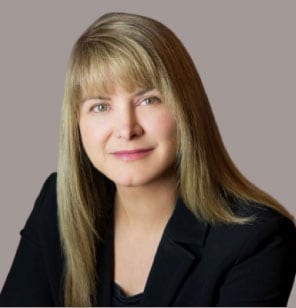
Pamela Arora serves as SVP and CIO at Children’s Health in Dallas, where she directs all Information Services efforts including systems and technology, Health Information Management, and Health Technology Management.
She has led the organization to achieve HIMSS Stage 7 Electronic Medical Record Adoption Model designation, InformationWeek500, InformationWeek Elite 100 and Most Wired designations, the HIMSS Enterprise Davies Award for the organization’s innovative use of the electronic health record, HITRUST Common Security Framework (CSF) and SECURETexas Certifications. Through her leadership, Children’s Health won the AHIMA Grace Award for excellence in Health Information Management, the CHIME/AHA Transformational Leadership Award for the organization’s work to promote cybersecurity across the continuum of care, and Infor’s Innovation in the Time of COVID-19.
Ms. Arora has been named to Becker’s 130 Women Hospital and Health System Leaders to know, received the HIMSS/CHIME John E. Gall CIO of the Year Award (2017), the CIO of the Year ORBIE Award (2018 nonprofit category), and Tech Titans Corporate CIO of the Year (2019). She is a lifetime member of the College of Healthcare Information Management Executives (LCHIME), a member of the Health Information and Management Systems Society (HIMSS), and the Children’s Hospital Association (CHA). Pamela currently serves on the AAMI Board, HITRUST Board, Dallas CIO Advisory Council, Tech Titans Board, Philips Global Medical Advisory and HIMSS North America Board.
Recent Episodes
About the host
Paddy is the co-author of Healthcare Digital Transformation – How Consumerism, Technology and Pandemic are Accelerating the Future (Taylor & Francis, Aug 2020), along with Edward W. Marx. Paddy is also the author of the best-selling book The Big Unlock – Harnessing Data and Growing Digital Health Businesses in a Value-based Care Era (Archway Publishing, 2017). He is the host of the highly subscribed The Big Unlock podcast on digital transformation in healthcare featuring C-level executives from the healthcare and technology sectors. He is widely published and has a by-lined column in CIO Magazine and other respected industry publications.

